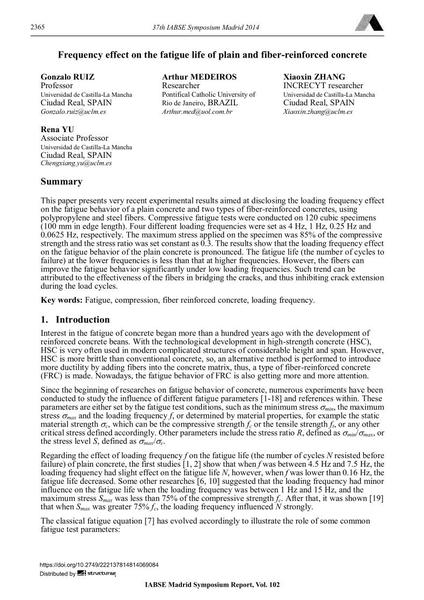Frequency effect on the fatigue life of plain and fiber-reinforced concrete

|
|
|||||||||||
Détails bibliographiques
| Auteur(s): |
Gonzalo Ruiz
Arthur Medeiros Xiaoxin Zhang Rena Yu |
||||
|---|---|---|---|---|---|
| Médium: | papier de conférence | ||||
| Langue(s): | anglais | ||||
| Conférence: | IABSE Symposium: Engineering for Progress, Nature and People, Madrid, Spain, 3-5 September 2014 | ||||
| Publié dans: | IABSE Symposium Madrid 2014 | ||||
|
|||||
| Page(s): | 2365-2372 | ||||
| Nombre total de pages (du PDF): | 8 | ||||
| Année: | 2014 | ||||
| DOI: | 10.2749/222137814814069084 | ||||
| Abstrait: |
This paper presents very recent experimental results aimed at disclosing the loading frequency effect on the fatigue behavior of a plain concrete and two types of fiber-reinforced concretes, using polypropylene and steel fibers. Compressive fatigue tests were conducted on 120 cubic specimens (100 mm in edge length). Four different loading frequencies were set as 4 Hz, 1 Hz, 0.25 Hz and 0.0625 Hz, respectively. The maximum stress applied on the specimen was 85% of the compressive strength and the stress ratio was set constant as 0.3. The results show that the loading frequency effect on the fatigue behavior of the plain concrete is pronounced. The fatigue life (the number of cycles to failure) at the lower frequencies is less than that at higher frequencies. However, the fibers can improve the fatigue behavior significantly under low loading frequencies. Such trend can be attributed to the effectiveness of the fibers in bridging the cracks, and thus inhibiting crack extension during the load cycles. |
||||
